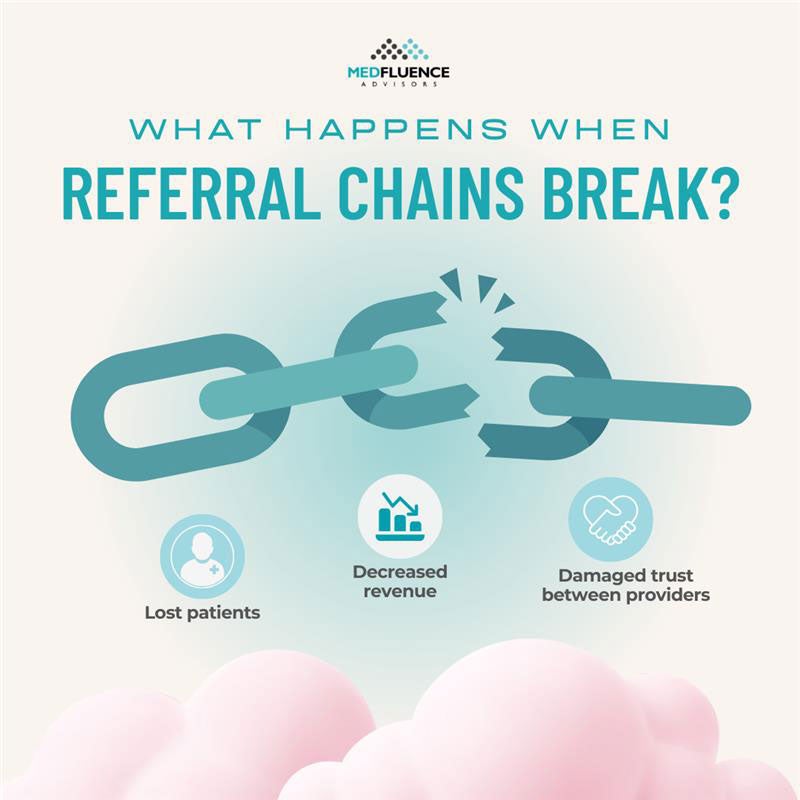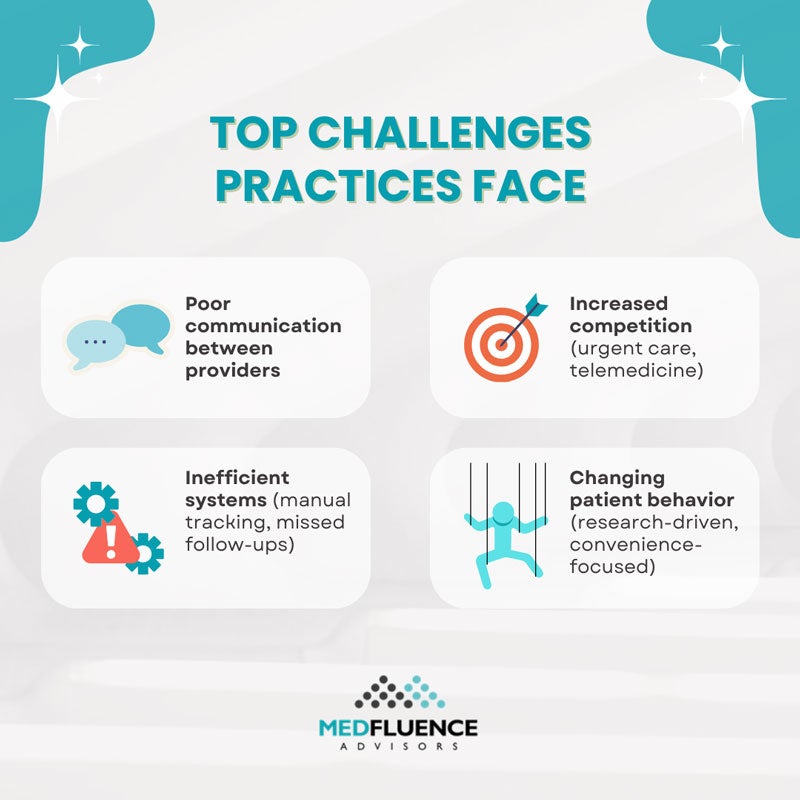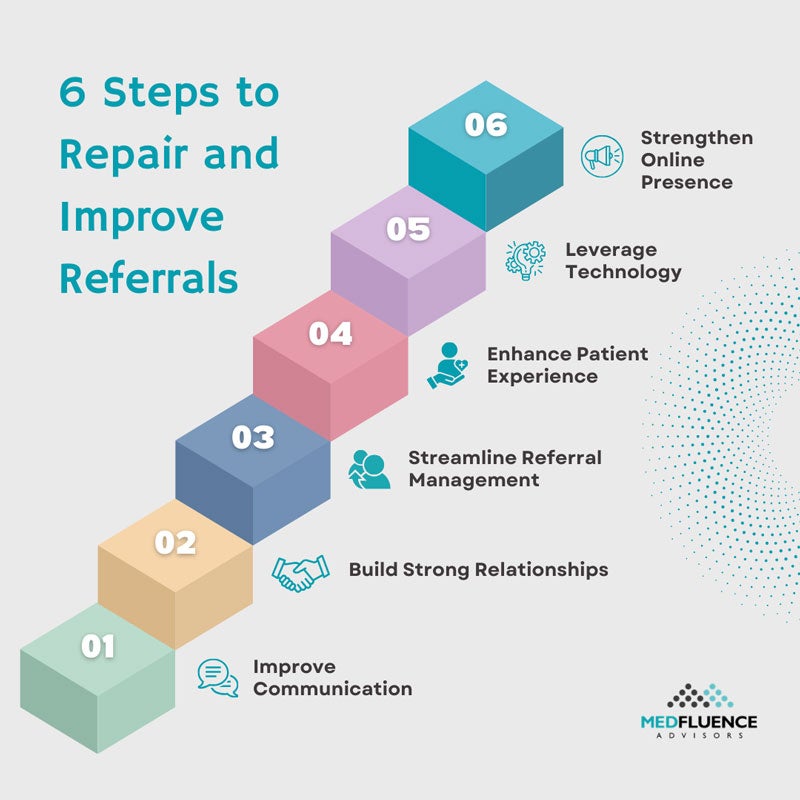Broken Referral Chains and How to Fix Them
Referral chains are a fundamental part of the healthcare ecosystem, acting as the bridge between different providers in a patient’s journey of care. In private practices, these chains serve as critical sources of patient acquisition, enabling physicians to reach individuals who may require specialized care or additional treatment. When referral chains are functioning well, they create a steady stream of patients, ensuring continuity of care and allowing practices to grow.
However, when a referral chain breaks, the consequences can be significant. A fractured referral system can lead to missed opportunities, decreased patient volume, and slower practice growth. The loss of trust or communication breakdowns between referring providers and receiving practices can prevent patients from accessing necessary care or choosing your practice for their needs. This disruption can cause a ripple effect that limits not just patient acquisition, but also retention and overall business success.

Challenges Faced by Small to Mid-Sized Practices
For small to mid-sized private practices, the challenge of maintaining a strong and reliable referral chain is even more pressing. These practices often operate with fewer resources and may not have the extensive networks that larger healthcare systems enjoy. Without a well-established system for managing referrals, practices can experience breakdowns in communication, lost referrals, or lack of follow-up, all of which can directly affect patient volume.
The reasons referral chains can break are varied, but some common factors include:
- Lack of Communication : Failure to keep referring providers informed or not ensuring proper follow-through can result in missed opportunities for patients to receive care at your practice.
- Increased Competition : With more options available to patients, especially through telemedicine and online research, they may bypass your practice in favor of others that offer perceived convenience or faster access to care.
- Evolving Patient Expectations : Today’s patients are more informed and empowered, with many researching healthcare options online and choosing providers based on convenience, cost, or reputation—factors that can weaken traditional referral chains.
These challenges can be particularly harmful to smaller practices trying to maintain their presence in a competitive and fast-evolving healthcare market.

What Are Referral Chains?
Referral chains in healthcare refer to the sequence of patient referrals from one healthcare provider to another. This process often begins with a primary care physician (PCP) who identifies a need for specialized care and refers the patient to a specialist or another healthcare provider. For example, a patient may be referred by their PCP to an orthopedic specialist, who may then refer them to a physical therapist, and so on. These interlinked connections form the foundation of a patient’s healthcare journey.
In private practices, referral chains are particularly important because they enable practices to reach new patients and ensure that individuals receive the right care at the right time. A well-established and efficient referral chain not only ensures continuity of care but also helps build a strong network of professional relationships that can support practice growth.
A broken referral chain, on the other hand, can create disruptions that lead to missed opportunities for patients to receive care, ultimately harming the practice’s growth. It’s crucial for practices to understand the role these referral chains play and to actively maintain and strengthen them for continued success.
The Importance of Strong, Reliable Referral Chains for Patient Continuity of Care and Practice Growth
A strong, reliable referral chain is essential for both patient continuity of care and the overall growth of a private practice. Referral chains ensure that patients are directed to the appropriate specialists or providers, which is critical for the correct diagnosis and effective treatment. These chains also foster the exchange of important medical information between providers, ensuring that care is coordinated and patients receive seamless treatment.
For practices, referral chains are a powerful tool for growth. They help establish a network of trust among providers and enable practices to tap into a steady stream of new patients. Moreover, a consistent flow of referrals can help mitigate patient acquisition costs and boost a practice’s reputation within the local healthcare community.
A broken or weak referral chain, on the other hand, can severely impact a practice’s growth potential. Patients may seek out alternative care options, referrals can be lost or delayed, and providers may be reluctant to refer patients to a practice that has not demonstrated consistent reliability.
The Role of Trust and Relationships in Referrals
Trust is the bedrock of any successful referral chain. When physicians trust other providers in their network, they are more likely to refer patients to them with confidence, knowing that their patients will receive high-quality care. Similarly, patients are more likely to follow through with a referral if they trust that their physician has made a recommendation that aligns with their needs. This trust is built through positive experiences, clear communication, and a demonstrated commitment to high standards of care.
For private practices, developing this trust requires building relationships with referring physicians and specialists. By being reliable, transparent, and communicative, a practice can establish itself as a trusted part of the healthcare network. When a practice is known for providing excellent care and following up on referrals, it strengthens its reputation and encourages further referrals.
Importance of Cultivating Relationships Within the Local Healthcare Network
Private practices that focus on cultivating relationships with other healthcare providers in their community are better positioned to benefit from consistent referrals. This can include establishing connections with primary care physicians, specialists, hospitals, and even local urgent care centers. Regular communication, attending networking events, and offering value through educational resources or collaboration opportunities can all help build these relationships.
The stronger the relationship a practice has within the local healthcare network, the more likely they are to receive referrals and patient recommendations. These relationships also provide a foundation for continuity of care, ensuring that patients are seen by the appropriate providers and receive comprehensive treatment.
The Common Reasons Referral Chains Break
Lack of Communication and Follow-Through
One of the most common reasons referral chains break is poor communication between providers. A referral system that lacks clear communication can lead to situations where patients are unaware of where they need to go for further care or follow-up appointments are missed. For example, a specialist may not inform the referring physician about a patient’s treatment plan, or a practice may fail to notify the referring physician when a patient has been successfully treated.
Additionally, failure to follow up on referrals can lead to missed opportunities to re-engage patients or make necessary adjustments to their care. Practices should have systems in place to ensure that all communication regarding referrals is clear, timely, and documented, making it easy for both the patient and the referring provider to stay informed throughout the process.
Increased Competition and Patient Choice
In today’s healthcare market, patients have more options than ever before. The rise of online health information, telemedicine, and even self-referrals means that patients are increasingly bypassing traditional referral pathways. When patients can research their options online or make appointments directly with specialists, the traditional referral chain can be disrupted. In particular, small to mid-sized private practices may find it difficult to compete with larger, more established networks that offer convenience or have a wider range of services available.
Additionally, patients now expect quick access to care, which can create a challenge for practices that rely heavily on referral chains. If a practice is unable to offer fast access or convenient care, patients may turn to alternatives, further weakening the referral chain.
Misalignment of Patient Expectations and Care Delivery
If a practice does not meet patient expectations, either through a poor experience or unsatisfactory treatment outcomes, it can result in a breakdown of trust and a loss of referrals. Patients are increasingly informed about their healthcare options, and if their needs aren’t met, they are more likely to seek care elsewhere. This misalignment of expectations can lead to fewer referrals from physicians, as well as negative word-of-mouth that affects the practice’s reputation.
Internal Practice Issues
Internal inefficiencies can also contribute to broken referral chains. For example, a practice that lacks an organized referral system or struggles with poor patient management may inadvertently lose referrals or delay follow-ups. Similarly, if a practice’s internal processes create long wait times or poor communication with patients, it can lead to patient dissatisfaction and a reluctance from referring physicians to continue sending patients. Addressing these internal operational inefficiencies is critical to maintaining a strong referral network.
Evolving Healthcare Market Dynamics
The evolving healthcare landscape, including changes in insurance policies, the rise of telemedicine , and the consolidation of larger healthcare groups, can also impact traditional referral chains. As healthcare providers adapt to new models of care, patients may find themselves with more choices and fewer reasons to rely on traditional referral systems. Telemedicine, for example, allows patients to access care remotely, bypassing the need for physical referrals and visits.
These changing dynamics can disrupt established referral patterns and require private practices to adapt their strategies in order to remain competitive. Practices that fail to understand and address these market shifts may find their referral chains weakening, leaving them at a disadvantage in the healthcare marketplace.
Strategies for Fixing Broken Referral Chains

Improving Communication Between Providers
One of the most important strategies for fixing broken referral chains is to improve communication between providers. This begins with ensuring that all parties involved in a referral are kept informed and updated. Practices should implement regular check-ins, set up feedback loops, and establish efficient referral tracking systems to ensure that referrals are not lost and that both the referring provider and receiving practice are aligned throughout the patient’s journey.
A streamlined communication process can help to reduce confusion, prevent misunderstandings, and ensure that the patient receives the care they need in a timely manner. Automated referral tracking systems and CRM platforms can also help ensure that every referral is followed up on, and every patient is attended to appropriately.
Building Strong Relationships with Referral Sources
To rebuild or strengthen referral chains, it is crucial to focus on building and maintaining relationships with referring physicians, specialists, and other healthcare professionals. Reconnecting with key referral sources can help reignite referral streams and rebuild trust. Practices should engage in networking, attend conferences or local medical events, and explore opportunities for continuing education or joint initiatives with other providers.
Strengthening relationships with referring physicians is a mutually beneficial process. When a practice provides consistent, quality care and communicates effectively with referring providers, they build a reputation that encourages ongoing referrals.
Setting Up Efficient Referral Management Systems
Having a well-organized referral management system is essential for ensuring that referrals are tracked and managed properly. Implementing a CRM or referral management software allows practices to automate referral tracking, follow-ups, and communication, reducing the likelihood of missed referrals. Additionally, these systems can help practices monitor referral trends and identify any areas where improvements are needed.
Automation tools can help practices streamline the referral process by automatically scheduling appointments, sending reminders, and notifying patients and providers of any updates. This not only reduces administrative overhead but also ensures that every referral is attended to promptly and efficiently.
Enhancing Patient Experience and Satisfaction
Providing an outstanding experience for patients is crucial in ensuring that they return and refer others to your practice. Every touchpoint, from the first contact with the practice to follow-up care, should reflect the practice’s commitment to patient-centered care. Ensuring that patients feel valued and informed throughout their referral process can increase the likelihood of them returning for future care and recommending the practice to others.
Additionally, referring physicians want to ensure that their patients are receiving high-quality care. Practices should make it easy for referring providers to access patient information, track patient progress, and receive timely updates on their patients’ outcomes.
Creating Patient-Centric Referral Programs
Patient referral programs can also be an effective strategy for rebuilding and strengthening referral chains. These programs incentivize patients to refer friends, family, or colleagues, expanding the practice’s reach. Offering rewards, discounts, or other incentives can motivate patients to refer others, which in turn strengthens the practice’s overall patient base.
Moreover, educating patients on the benefits of referrals and how they contribute to their care can create a mutually beneficial cycle. When patients understand that referring others can help their loved ones receive the same level of care, they may be more likely to engage in the referral process.
Leveraging Technology and Data for Smarter Referrals
Utilizing technology is essential for improving and tracking referral chains. Electronic Health Records (EHR), practice management software, and data analytics can help practices identify referral trends, track referral sources, and optimize the referral process. These tools provide valuable insights into how referrals are performing, which sources are the most reliable, and where improvements can be made.
Telemedicine, in particular, can be a powerful tool for expanding referral networks and maintaining relationships with out-of-area specialists. By offering virtual consultations, practices can increase their reach and make it easier for patients to connect with the right providers, even if they are not located locally.
Establishing Referral Agreements and Partnerships
Formalizing referral relationships through written agreements or partnerships can further strengthen your practice’s referral network. By establishing clear expectations and guidelines for referrals, practices can avoid confusion and ensure that both parties understand the mutual benefits. Joint marketing efforts, shared initiatives, or collaborative events can also help both parties grow their patient base.
Local SEO and Online Presence
A strong online presence and optimized website are essential for attracting both patients and providers who may refer patients to your practice. Local SEO ensures that your practice shows up in search results when potential patients or healthcare providers are looking for services in your area. It’s important to ensure that your practice’s website is easy to navigate and provides clear information on the services you offer.
Building Your Practice’s Reputation
Positive patient reviews, testimonials, and educational content play a key role in fostering trust and encouraging referrals. Providing high-quality content that educates both patients and healthcare providers can help establish your practice as a trusted source of care.
Social Media and Networking
Social media platforms like LinkedIn and Facebook can be useful for networking with other healthcare providers and building professional relationships. Sharing patient success stories, medical tips, and news about your practice can also increase your visibility and help generate more referrals.
Content Marketing for Education
Content marketing, such as blogs, webinars, or videos, can help you educate both patients and potential referral sources about your practice’s services. Offering valuable insights and information establishes your practice as a thought leader and builds credibility within your network.
Measuring Success and Continuously Improving Referral Chains

Tracking and Analyzing Referral Metrics
Key performance indicators (KPIs) such as referral conversion rates, engagement with referral sources, and patient satisfaction can help measure the effectiveness of your referral efforts. By regularly analyzing these metrics, practices can identify what’s working and where adjustments may be needed.
Regularly Reviewing Referral Sources
Regular reviews of referral sources help practices stay engaged with providers and ensure that referral relationships are strong. By identifying which sources are performing well, practices can focus their efforts on nurturing those relationships and re-engaging with underperforming sources.
Adapting to Market Changes
Staying flexible and adapting referral strategies in response to changing market dynamics and patient preferences is essential. Embracing new technologies, adjusting to the growth of telemedicine, and responding to shifts in patient expectations can all help practices maintain and strengthen their referral chains.
Strengthening Referral Chains for Sustainable Growth
In the competitive healthcare landscape, maintaining strong and reliable referral chains is essential for the growth and success of private practices. A broken referral chain not only leads to lost revenue opportunities but also impacts patient retention, the practice’s reputation, and the efficiency of its operations. By understanding the dynamics of referral relationships, addressing the common causes of disruptions, and implementing effective strategies, practices can rebuild and strengthen their referral networks.
The key to revitalizing referral chains lies in improving communication, fostering strong relationships with referring physicians, and leveraging technology to streamline processes. It’s also essential to offer an exceptional patient experience that encourages return visits and generates organic word-of-mouth referrals. Creating patient-centric referral programs, formalizing partnerships, and using data analytics to optimize referral efforts will further contribute to a more robust and sustainable referral network.
In an evolving healthcare market, practices that proactively address broken referral chains and implement thoughtful, patient-focused strategies will not only boost their patient acquisition but also build long-term trust with both patients and referring providers. By continuously improving referral processes and adapting to new technologies and market shifts, private practices can ensure their long-term growth and success in a dynamic and competitive healthcare environment. Make the change today!


